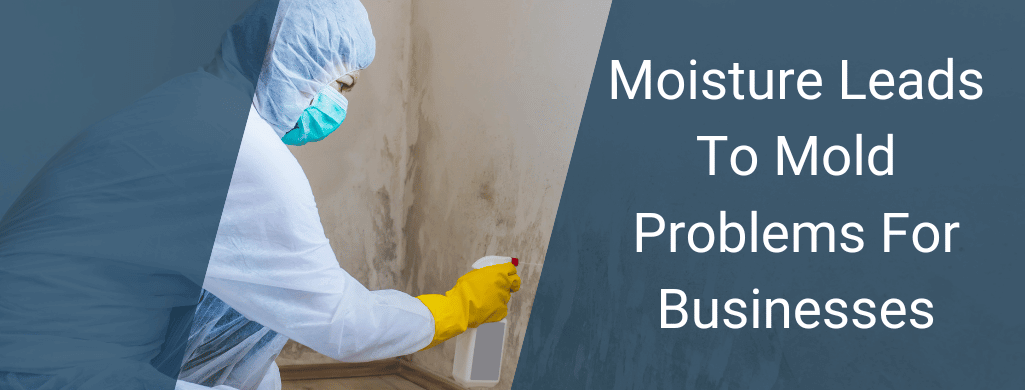The spring and summer months can be difficult for many schools, hospitals, and businesses in the northeast. The weather has been consistently hot, rainy, and very humid. These hot, humid conditions can act as an incubator for mold in buildings where no humidity control is in place.
Local Schools Have A Mold Problem
There have been news stories about mold in schools. This leads to delaying classes because of visible mold in classrooms that remained unoccupied during the summer months. Costly investigations into the extent of mold contamination and even more costly remediation/clean up activities can put an undo financial burden on any school or business.
Moisture Leads To Mold In Buildings
Mold and moisture go hand and hand. Mold thrives indoors in hot, humid weather where humidity control such as air conditioning, is not in place or is not used in a way that effectively lowers the relative humidity in the space.
How To Keep Your Business From Having A Mold Problem
There are a few steps to stopping your business from having a mold issue. To stop mold, you must lower the amount of moisture in your building.
1. AIR CONDITIONING REMOVES MOISTURE FROM THE AIR
Air conditioners remove moisture from the air and fungal growth is less likely to occur in areas where the relative humidity is less than 60%, however, in many buildings, especially schools, that operate at less than capacity during the summer months, warm, humid air conditions provide a perfect environment for fungal growth.
2. MAINTAIN YOUR BUILDINGS MOISTURE WITH HUMIDITY CONTROL
The primary key to avoiding mold growth in your building is humidity control. It is imperative that relative humidity be kept below 60% to prevent mold from growing.
3. REGULARLY INSPECT YOUR BUILDING FOR MOLD
Another key factor in controlling mold growth is the identification and regular inspection of areas that may be susceptible to fungal growth. These inspections provide the building owner/property manager a real time look at what is occurring in their building.
Standards To Keep Your Building Safe From Mold
Although there are no federally enacted regulations related to the indoor air quality industry, several standards exist to assist industry professionals. PROAC Corporation has adopted the American Standard Testing Materials (ASTM) standard D 7338-14, “Standard Guide for Assessment of Fungal Growth in Buildings” as our reference for completing indoor air quality investigations.
 ASTM is an international standards organization that develops and publishes voluntary, consensus technical standards for a wide range of products and services. Federal, state and municipal regulations have adopted many ASTM standards.
ASTM is an international standards organization that develops and publishes voluntary, consensus technical standards for a wide range of products and services. Federal, state and municipal regulations have adopted many ASTM standards.
This guideline presents a framework for locating and evaluating suspect fungal growth in buildings. Components of a basic assessment strategy include the following: 1) defining a scope of work, 2) collecting background information related to the building, 3) formulation of a hypothesis, 4) an on site survey for fungi, moisture dynamics and HVAC operation and 5) documentation and reporting.
Additionally, both the National Air Duct Cleaners Association (NADCA) in their document “Assessment, Cleaning and Restoration 2015” standard ACR 2015 and the American Society of Heating, Refrigeration and Air Conditioning Engineers (ASHRAE) in their “Standard Practice for Inspection and Maintenance of Commercial Building HVAC systems” standard 180-2016 suggest a proactive approach to HVAC inspections and maintenance as a means of lowering operating/maintenance costs and insuring that these systems operate in a manner that supplies good, conditioned air to the breathing zone.
PROAC Corporation is a longstanding member of both NADCA and ASHRAE. As our name indicates, we are proponents of proactive maintenance. Proactive surveys help to prevent fungal problems from starting in the first place. We offer an IAQ/HVAC survey program designed to identify conditions that may aid in fungal growth.
How PROAC Stops Mold In Your Business
We perform air quality testing, HVAC video inspection, mold removal and remediation, duct cleaning, and ongoing HVAC hygiene control and maintenance. All of these services are designed to stop mold in its tracks and make sure your business’s air quality, as well as building quality, is taken care of.
We offer recommended actions designed to rectify the undesirable conditions. Our program includes completing an initial survey to establish background information including readings of Temperature, Relative Humidity (RH), Carbon Dioxide (C02), Carbon Monoxide (CO), Total Volatile Organic Compounds (TVOC) and Particle Counts. The survey also includes a visual inspection of all occupied areas and of the Air Handler Units (AHU’s). Reports with photo documentation are provided.
ACAC accredited Certified Indoor Environmental Consultants (CIEC) and NADCA accredited Certified Ventilation Inspectors (CVI) complete the surverys.
For more information on this valuable service, Please visit our webpage at www.proaccorp.com or contact us directly at (717)933-9475 for all your indoor air quality needs.

